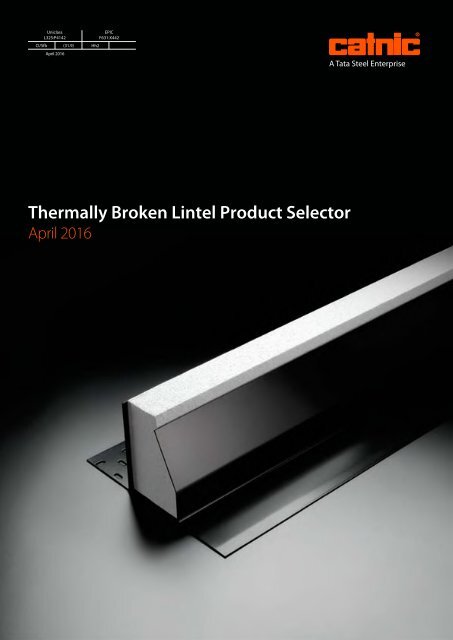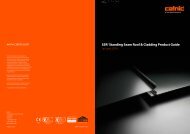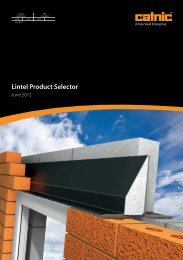You also want an ePaper? Increase the reach of your titles
YUMPU automatically turns print PDFs into web optimized ePapers that Google loves.
CI/Sfb<br />
Uniclass<br />
L325:P4142<br />
April 2016<br />
(31.9) Hh2<br />
EPIC<br />
F631:X442<br />
<strong>Thermally</strong> <strong>Broken</strong> <strong>Lintel</strong> <strong>Product</strong> <strong>Selector</strong><br />
April 2016
Contents<br />
4 Technically Superior <strong>Product</strong>s<br />
5 <strong>Thermally</strong> <strong>Broken</strong> <strong>Lintel</strong><br />
Solution<br />
6 Thermal Performance<br />
8 Structural Performance<br />
9 <strong>Thermally</strong> <strong>Broken</strong> <strong>Lintel</strong>s<br />
BUILD IT BETTER<br />
WITH CATNIC<br />
Catnic has pioneered the steel lintel for almost 50<br />
years and designs, manufactures and supplies the<br />
construction industry with technically superior<br />
products.<br />
Catnic was the first:<br />
• <strong>Lintel</strong> manufacturer to be listed on the BRE<br />
Certified Thermal Details and <strong>Product</strong>s<br />
scheme<br />
• <strong>Lintel</strong> manufacturer to be certified to BES<br />
6001, maximising the potential for obtaining<br />
credits under the Responsible Sourcing of<br />
Materials sections of BREEAM, the Code for<br />
Sustainable Homes and CEEQUAL<br />
• To develop the steel lintel in the UK and<br />
the first to gain both BBA Approval and the<br />
coveted Kitemark to BS 5977<br />
• To provide a built-in plaster key<br />
• Was the first to CE mark its lintel<br />
product range<br />
Far from just leading, over the years Catnic<br />
have worked with the BSI to establish the<br />
standards for lintels in this country and<br />
continue to develop and invest in improving<br />
on these standards with their extensive range<br />
of products and unique features.<br />
• Manufacturer to employ the revolutionary<br />
Duplex Corrosion Protection System on its<br />
lintel as a standard offering<br />
• To incorporate a built-in damp proof course<br />
into its lintels<br />
2<br />
3
TECHNICALLY SUPERIOR<br />
PRODUCTS<br />
<strong>Thermally</strong> broken<br />
<strong>Lintel</strong> Solution<br />
Catnic is committed to innovation and constant improvement<br />
to meet the changes in building regulations.<br />
Catnic’s latest innovation is the biggest evolution in steel lintel design<br />
for a generation. An elegant, simplistic design derived from extensive<br />
research and rigorous development testing.<br />
Leaders in Technical Innovation<br />
Our rigid adherence to quality control & compliance is your guarantee of technical superiority.<br />
Offering a sophisticated, practical solution to the latest changes in Building<br />
Regulations, Catnic’s patent pending TBL range is the most thermally efficient<br />
steel lintel solution on the market.<br />
Quality<br />
Catnic are committed to quality control and<br />
is a BSI registered company with quality<br />
management systems in accordance with BS EN<br />
ISO 9001: 2015, which provide a set of processes<br />
that ensure:<br />
• Clarification and documentation of policies<br />
and objectives<br />
• Reduce waste relating to customers’<br />
requirements to production with a view to<br />
achieving customer satisfaction<br />
• Understanding how statutory and regulatory<br />
requirements impact on Catnic and our<br />
customers<br />
• Clear responsibilities and authorities -<br />
increasing motivation and commitment<br />
• Consistency and traceability of products<br />
and services<br />
• High level of internal and external<br />
communications<br />
Material Specification<br />
Catnic’s standard lintels are manufactured<br />
from high quality grade galvanised steel to<br />
BS EN 10346: 2009 Z275, with a black coloured<br />
polyester resin finish.<br />
Thermal Performance / Insulation<br />
All Catnic lintels for traditional external cavity<br />
walls are supplied fully insulated. Insulation<br />
extends continuously along the full length of<br />
the lintel, leaving no potential thermal bridges<br />
and cannot be dislodged.<br />
Structural Performance<br />
The structural data published in the loading<br />
tables included in this technical guide, was<br />
achieved in accordance with the requirements<br />
BS EN 845-2: 2015.<br />
Independent Testing<br />
Extensive testing was undertaken at the<br />
following test houses:<br />
• The University of South Wales, Commercial<br />
Services Centre for Engineering, Research and<br />
Environmental Applications (CEREA)<br />
• BRE Building Research Establishment<br />
Environment and Sustainability<br />
Catnic are committed to protecting the<br />
environment by minimising the impact of<br />
our operations and our products through the<br />
adoption of sustainable practices and through<br />
continuous improvement<br />
in environmental<br />
performance and control.<br />
Utilising the strength of steel combined with the thermal insulating<br />
properties of a high-density, fire retardant core, it’s design provides the<br />
thermal performance of separate lintels, whilst offering users the same<br />
stable installations benefits of a traditional cavity wall lintel, providing:<br />
• Industry leading linear thermal<br />
transmittance Psi values of 0.02 to 0.05 W/mK<br />
• Safe working loads in line with Catnic’s existing Cavity wall lintels<br />
• Manufactured from powder coated galvanised steel<br />
• Options are available to suit cavities from 90 to 165mm, in standard,<br />
heavy and extra heavy duty performance categories<br />
Achieving this remarkably low Psi value ensures Catnic’s TBL range<br />
will always meet the performance criteria requirements of Appendix R<br />
found in SAP 2012 providing easy compliance with Part L of the Building<br />
Regulations.<br />
To limit the risk of surface condensation or mould growth the temperature<br />
factor for a detail used in the external wall of a dwelling must be greater<br />
than 0.75. Catnic <strong>Thermally</strong> <strong>Broken</strong> <strong>Lintel</strong>s a have temperature factor of at<br />
least 0.95.<br />
This unique design enables a complete thermal break between<br />
the inner and outer leaf of the cavity wall construction, results in<br />
outstanding thermal performance values of:<br />
Psi value 0.02 to 0.05 W/mK<br />
Independently verified by the Building Research<br />
Establishment. See<br />
www.bre.co.uk/certifiedthermalproducts<br />
for further details and certification.<br />
BS EN ISO 9001 : 2015<br />
FM 14913 BS EN ISO 14001 : 2015<br />
EMS 555046<br />
Regulatory authorities approval<br />
Catnic’s excellence is internationally recognised.<br />
Catnic lintels have gained the approval of the regulatory authorities<br />
both in the domestic and international markets. Such wide-spread<br />
comprehensive approval is an assurance to designers, specifiers and<br />
builders of the reliability and state-of-the-art quality of the Catnic range.<br />
High density insulating core<br />
providing thermal break<br />
Powder Coated Steel inner leaf<br />
support bonded to core<br />
BS EN 845-2 : 2013<br />
KM 07234<br />
91/2638<br />
BSI Kitemark<br />
Catnic steel lintels have<br />
been awarded the BSI<br />
Kitemark license number<br />
KM 07234.<br />
BBA Certification<br />
Catnic steel lintels are<br />
certified by the British<br />
Board of Agrément<br />
under certificate number<br />
91/2638.<br />
Fully Part L Compliant<br />
Catnic steel lintels<br />
comply with Parts L1<br />
and L2 of the Building<br />
Regulations Approved<br />
Documents. LABC in<br />
England and Wales.<br />
BES 6001 Certification<br />
Catnic lintels are the first<br />
of its type to have been<br />
certified as responsibly<br />
sourced from the iron<br />
ore supply to installation.<br />
Local Authority<br />
Building Control (LABC)<br />
Catnic steel lintels are<br />
compliant with current<br />
UK Building Regulations<br />
and therefore meet the<br />
requirements of the LABC<br />
in England and Wales.<br />
National House-<br />
Building Council (NHBC)<br />
Catnic steel lintels<br />
meet NHBC technical<br />
requirements.<br />
Powder Coated Steel outer leaf<br />
support bonded to core<br />
4 <strong>Thermally</strong> <strong>Broken</strong> <strong>Lintel</strong> <strong>Product</strong> <strong>Selector</strong> Technically Superior <strong>Product</strong>s<br />
5
THERMAL PERFORMANCE<br />
THERMAL PERFORMANCE<br />
The Fabric Energy Efficiency Standard (FEES) forms the<br />
foundations of the Building Regulations Part L 2013.<br />
This focuses on the thermal performance for walls,<br />
roof and floors of the building, which have been<br />
continually improved with the revisions to the<br />
regulations.<br />
Improving the thermal performance of the walls emphasises the<br />
increasing proportion of heat lost through thermal bridges in the<br />
building fabric such as lintels if these details are not improved. The<br />
heat lost through linear thermal bridges in called the Psi value and is<br />
measured in W/mK.<br />
Replacing the traditional lintels with a Catnic <strong>Thermally</strong> <strong>Broken</strong> <strong>Lintel</strong> the<br />
heat loss through the window head detail can be reduced by up to 96%.<br />
Existing default psi values for lintels as listed in BRE IP 1/06 are shown<br />
below: -<br />
Junction detail in external wall Default Psi value (W/m.K)<br />
Steel lintel with perforated base plate 0.5<br />
Other lintels 0.3<br />
On a typical 4 bedroom house with a floor area of 57 m 2 , the heat loss<br />
through a standard lintel can account for about 6%* of the overall heat<br />
loss through the fabric of the house. Using a Catnic <strong>Thermally</strong> <strong>Broken</strong><br />
<strong>Lintel</strong> reduces this to 0.25% making it effectively insignificant.<br />
* based on a default lintel psi value of 0.5 W/mK<br />
G<br />
E<br />
F<br />
SAP 2012 Appendix R<br />
Part L of the Building Regulations has got progressively more<br />
complicated. To make it easier to comply an optional “standard recipe”,<br />
based on the Part L 2013 Notional dwelling, has been introduced. A<br />
summary is shown in the table opposite, full details can be found in Sap<br />
2012 Appendix R.<br />
If you follow the standard recipe you will achieve the CO 2 and fabric<br />
energy efficiency targets to comply with Part L. The standard recipe<br />
requires a lintel Psi value of 0.05 W/mK. All Catnic <strong>Thermally</strong> <strong>Broken</strong><br />
<strong>Lintel</strong>s will provide Psi values of 0.05 W/mK or better.<br />
Summery of notional building requirements<br />
Opening Areas<br />
Same as actual up to 25% of floor area<br />
Ext. Wall (W/m 2 K) 0.18<br />
Party Walls (W/m 2 K) 0<br />
Floor (W/m 2 K) 0.13<br />
Roof (W/m 2 K) 0.13<br />
Windows (W/m 2 K) 1.4<br />
Air Tightness 5<br />
Non repeating thermal bridging Standard Psi values from Appendix R of SAP<br />
Ventilation Type<br />
Natural (with extracts)<br />
Gas Boiler 89.5%<br />
C<br />
B<br />
A<br />
30<br />
Two-dimensional temperature distribution, highlighting the effectiveness of the<br />
thermal break in the lintel.<br />
Catnic have worked closely with the University of South Wales to develop<br />
and test both the thermal and structural properties of the TBL Range.<br />
1.3 Materials<br />
10mm airspace + Dabs [R = 0.11]<br />
∴ λ = 0.01/0.11 = 0.09W/mK<br />
Thickness<br />
(mm)<br />
λ Value<br />
(w/m.k)<br />
A Window frame - -<br />
B<br />
Plasterboard<br />
+ Adhesive<br />
12.5<br />
10.0<br />
0.19<br />
0.09<br />
C<br />
Plasterboard on<br />
Dabs + Air Space<br />
12.5<br />
10.0<br />
0.19<br />
0.09<br />
D Blockwork 100 0.11<br />
E Insulation As required 0.022<br />
F Brick 103 0.077<br />
G Residual Cavity 50 0.278<br />
<strong>Lintel</strong><br />
Steel - 52<br />
Insulation - 0.034<br />
Comment: Continuous band of adhesive to soffit area<br />
Typical detail used for Thermal Modelling of the TBL Range<br />
6<br />
<strong>Thermally</strong> <strong>Broken</strong> <strong>Lintel</strong> <strong>Product</strong> <strong>Selector</strong> Thermal Performance<br />
7
Structural PERFORMANCE<br />
The Catnic <strong>Thermally</strong> <strong>Broken</strong> <strong>Lintel</strong> range has been developed to provide<br />
the exact same safe working loads capacity of the standard Catnic range<br />
of cavity wall lintels.<br />
ThermallY <strong>Broken</strong><br />
LINTELS<br />
90-105mm Cavity<br />
100-115mm Inner Leaf<br />
Standard Duty<br />
All ratios are shown<br />
inner to outer<br />
110-125mm Cavity<br />
100-115mm Inner Leaf<br />
Standard Duty<br />
TS, TH & TX<br />
90 - 105mm<br />
cavitY WALL<br />
This allows a very simple conversion from the existing Catnic cavity wall range<br />
to the TBL range without having to re-assess the loads over the lintels.<br />
The range has been designed to cover all<br />
building types from small domestic dwellings<br />
up to and including large apartment blocks<br />
with concrete floors.<br />
The composite design means the lintel is very<br />
stable during installation, allowing it to be<br />
installed in the same way as a standard steel<br />
lintel with no propping required.<br />
<strong>Lintel</strong> design has been completed in line with<br />
EN 845-2. Structural Testing was carried out<br />
by the University of South Wales following<br />
EN 846-9. The University of South Wales is a<br />
Notified Testing Laboratory for the Testing<br />
of <strong>Lintel</strong>s as required by the Construction<br />
<strong>Product</strong>s Directive.<br />
If you require further information<br />
please contact our Technical<br />
Services Department on<br />
029 2033 7900<br />
Standard lengths are available in 150mm<br />
increments up to 3000mm, 300mm at<br />
lengths from 3000mm to 3600mm.<br />
TS90/100<br />
Standard lengths (mm)<br />
750-<br />
1500<br />
1650-<br />
1800<br />
1950-<br />
2100<br />
2250-<br />
2400<br />
2550-<br />
2700<br />
2850-<br />
3600<br />
SWL 1:1/3:1 (kN) 15 18 20 22 26 26<br />
Weight (kg/m) 7.9 11.8 11.8 15.7 15.7 16.7<br />
Nominal height ‘h’ (mm) 153 202 202 233 233 229* Nominal height ‘h’ (mm) 153 202 202 233 233 229*<br />
* channel to inner leaf * channel to inner leaf<br />
Heavy Duty<br />
Standard lengths are available in 150mm<br />
increments up to 3000mm, 300mm at<br />
lengths from 3000mm to 3600mm.<br />
TS110/100<br />
Standard lengths (mm)<br />
750-<br />
1500<br />
1650-<br />
1800<br />
1950-<br />
2100<br />
2250-<br />
2400<br />
2550-<br />
2700<br />
2850-<br />
3600<br />
SWL 1:1/3:1 (kN) 15 18 20 22 26 26<br />
Weight (kg/m) 8.0 11.9 11.9 15.8 15.8 16.9<br />
Heavy Duty<br />
Standard lengths are available<br />
in 150mm increments.<br />
Standard lengths are available<br />
in 150mm increments.<br />
TH90/100<br />
TH110/100<br />
Performance Gap<br />
In recent years, the housebuilding industry,<br />
government and Zero Carbon Hub have<br />
grown increasingly concerned over the<br />
potential gap between design and as-built<br />
energy performance.<br />
The specifically designed flat top of Catnic’s<br />
<strong>Thermally</strong> <strong>Broken</strong> <strong>Lintel</strong> provides a simple,<br />
consistent junction with the cavity wall<br />
insulation removing the reliance on site<br />
workmanship, ensuring as built performance of<br />
the junction meets the design performance.<br />
There are NO brackets connecting the inner and<br />
outer leaf of the lintel and therefore there are<br />
NO additional point thermal bridges that need<br />
to be considered.<br />
Benefits<br />
Materials used in <strong>Lintel</strong>s<br />
The lintels are formed from galvanised<br />
steel, then powder coated<br />
Duplex corrosion protection<br />
Ensures optimum durability and longevity<br />
<br />
Psi<br />
Outsianding thermal perfprmace Psi value<br />
0.02 to 0.05 W/mK exceeds Appendix R<br />
of SAP<br />
Thermal Break<br />
Unique design enables a complete<br />
thermal break between the inner and<br />
outer leaf of the cavity wall construction<br />
Standard lengths (mm) 900-1800 1950-2100 2250-2400<br />
SWL 1:1/19:1 (kN) 32 48 45<br />
Weight (kg/m) 13.3 16.7 16.7<br />
Nominal height ‘h’ (mm) 154 229 229<br />
Extra Heavy Duty<br />
Standard lengths are available in 150mm<br />
increments up to 3000mm, 300mm at<br />
lengths 3000mm to 4800mm (including<br />
4575mm, but excluding 4500mm).<br />
TX90/100<br />
Standard lengths (mm)<br />
900-<br />
2100<br />
2200-<br />
2700<br />
2850-<br />
300<br />
3300-<br />
3600<br />
3900-<br />
4800<br />
SWL 1:1/19:1 (kN) 60 60 55 50 32<br />
Weight (kg/m) 16.7 21.6 21.6 21.6 21.6<br />
Standard lengths (mm) 900-1800 1950-2100 2250-2400<br />
SWL 1:1/19:1 (kN) 32 48 45<br />
Weight (kg/m) 13.4 16.9 16.9<br />
Nominal height ‘h’ (mm) 154 229 229<br />
Extra Heavy Duty<br />
Standard lengths are available in 150mm<br />
increments up to 3000mm, 300mm at<br />
lengths 3000mm to 4800mm (including<br />
4575mm, but excluding 4500mm).<br />
TX110/100<br />
Standard lengths (mm)<br />
900-<br />
2100<br />
2200-<br />
2700<br />
2850-<br />
300<br />
3300-<br />
3600<br />
3900-<br />
4800<br />
SWL 1:1/19:1 (kN) 60 60 55 50 32<br />
Weight (kg/m) 16.9 21.7 21.7 21.7 21.7<br />
Nominal height ‘h’ (mm) 229 229 229 229 229 Nominal height ‘h’ (mm) 229 229 229 229 229<br />
Continuous insulation<br />
Flat top of lintel<br />
Maximising thermal efficiency, minimising<br />
Concrete Floor Loads<br />
provides consistent<br />
Note: To achieve the ‘TH and TX’ loading<br />
cold bridging<br />
The SWL (safe working When using the Catnic TH and TX open back ranges with<br />
junction with cavity<br />
figures indicated, lintels must be built-in<br />
wall insulation<br />
i load) is based on the total concrete floors, always ensure that the blockwork is built<br />
as illustrated, ensuring that the blockwork<br />
UDL (uniform distributed tight against the inner vertical face of the lintel and that a<br />
infill is well-jointed during construction<br />
load) over maximum span mortar joint is added to the top of the blockwork so that<br />
and compatible with the strength of the<br />
using 150mm end bearings. the floor units have an even spread over the inner flange of<br />
masonry above.<br />
the lintel.<br />
8 <strong>Thermally</strong> <strong>Broken</strong> <strong>Lintel</strong> <strong>Product</strong> <strong>Selector</strong> Structural Performance<br />
9
TS, TH & TX<br />
150 - 165mm<br />
cavitY WALL<br />
ThermallY <strong>Broken</strong><br />
LINTELS<br />
130-145mm Cavity<br />
100-115mm Inner Leaf<br />
Standard Duty<br />
All ratios are shown<br />
inner to outer<br />
150-165mm Cavity<br />
100-115mm Inner Leaf<br />
Standard Duty<br />
All ratios are shown<br />
inner to outer<br />
Standard lengths are available in 150mm<br />
increments up to 3000mm, 300mm at<br />
lengths from 3000mm to 3600mm.<br />
Standard lengths are available in 150mm<br />
increments up to 3000mm, 300mm at<br />
lengths from 3000mm to 3600mm.<br />
TS130/100<br />
Standard lengths (mm)<br />
750-<br />
1500<br />
1650-<br />
1800<br />
1950-<br />
2100<br />
2250-<br />
2400<br />
2550-<br />
2700<br />
2850-<br />
3600<br />
SWL 1:1/3:1 (kN) 15 18 20 22 26 26<br />
Weight (kg/m) 8.1 12.0 12.0 16.0 16.0 17.0<br />
TS150/100<br />
Standard lengths (mm)<br />
Nominal height ‘h’ (mm) 153 202 202 233 233 229* Nominal height ‘h’ (mm) 153 202 202 233 233 229*<br />
* channel to inner leaf * channel to inner leaf<br />
750-<br />
1500<br />
1650-<br />
1800<br />
1950-<br />
2100<br />
2250-<br />
2400<br />
2550-<br />
2700<br />
2850-<br />
3600<br />
SWL 1:1/3:1 (kN) 15 18 20 22 26 26<br />
Weight (kg/m) 8.2 12.2 12.2 16.1 16.1 17.1<br />
Heavy Duty<br />
Heavy Duty<br />
Standard lengths are available<br />
in 150mm increments.<br />
Standard lengths are available<br />
in 150mm increments.<br />
TH130/100<br />
Standard lengths (mm) 900-1800 1950-2100 2250-2400<br />
SWL 1:1/19:1 (kN) 32 48 45<br />
Weight (kg/m) 13.5 17.0 17.0<br />
Nominal height ‘h’ (mm) 154 229 229<br />
TH150/100<br />
Standard lengths (mm) 900-1800 1950-2100 2250-2400<br />
SWL 1:1/19:1 (kN) 32 48 45<br />
Weight (kg/m) 13.6 17.1 17.1<br />
Nominal height ‘h’ (mm) 154 229 229<br />
Extra Heavy Duty<br />
Extra Heavy Duty<br />
Standard lengths are available in 150mm<br />
increments up to 3000mm, 300mm at<br />
lengths 3000mm to 4800mm (including<br />
4575mm, but excluding 4500mm).<br />
TX130/100<br />
Standard lengths (mm)<br />
900-<br />
2100<br />
2200-<br />
2700<br />
2850-<br />
300<br />
3300-<br />
3600<br />
3900-<br />
4800<br />
SWL 1:1/19:1 (kN) 60 60 55 50 32<br />
Weight (kg/m) 17.0 21.9 21.9 21.9 21.9<br />
Nominal height ‘h’ (mm) 229 229 229 229 229<br />
Standard lengths are available in 150mm<br />
increments up to 3000mm, 300mm at<br />
lengths 3000mm to 4800mm (including<br />
4575mm, but excluding 4500mm).<br />
TX150/100<br />
Standard lengths (mm)<br />
900-<br />
2100<br />
2200-<br />
2700<br />
2850-<br />
300<br />
3300-<br />
3600<br />
3900-<br />
4800<br />
SWL 1:1/19:1 (kN) 60 60 55 50 32<br />
Weight (kg/m) 17.1 22.0 22.0 22.0 22.0<br />
Nominal height ‘h’ (mm) 229 229 229 229 229<br />
Concrete Floor Loads<br />
Note: To achieve the ‘TH and TX’ loading<br />
The SWL (safe working When using the Catnic TH and TX open back ranges with<br />
figures indicated, lintels must be built-in<br />
i load) is based on the total concrete floors, always ensure that the blockwork is built<br />
as illustrated, ensuring that the blockwork<br />
UDL (uniform distributed tight against the inner vertical face of the lintel and that a<br />
infill is well-jointed during construction<br />
load) over maximum span mortar joint is added to the top of the blockwork so that<br />
and compatible with the strength of the<br />
using 150mm end bearings. the floor units have an even spread over the inner flange of<br />
masonry above.<br />
the lintel.<br />
10 <strong>Thermally</strong> <strong>Broken</strong> <strong>Lintel</strong> <strong>Product</strong> <strong>Selector</strong> <strong>Thermally</strong> <strong>Broken</strong> <strong>Lintel</strong>s<br />
11
www.catnic.com<br />
Care has been taken to ensure that the<br />
contents of this publication are accurate, but<br />
Tata Steel Europe Limited and its subsidiaries,<br />
which includes Tata Steel UK Limited, do not<br />
accept responsibility or liability for errors<br />
or information that is found to be misleading.<br />
Suggestions for, or descriptions of, the end use<br />
or application of products or methods of working<br />
are for information only and Tata Steel Europe<br />
Limited and its subsidiaries accept no liability in<br />
respect thereof.<br />
Before using products or services supplied or<br />
manufactured by Tata Steel Europe Limited<br />
and its subsidiaries, customers should satisfy<br />
themselves as to their suitability.<br />
Catnic reserves the right to change information<br />
contained within this brochure at any time.<br />
© Copyright 2016 Tata Steel UK Limited<br />
Catnic<br />
Pontypandy Industrial Estate<br />
Caerphilly<br />
CF83 3GL<br />
T: 029 2033 7900<br />
F: 029 2086 7796<br />
www.catnic.com<br />
EN 845-2<br />
EN 1090-1<br />
BS EN ISO 9001 : 2015<br />
FM 14913<br />
BS EN ISO 14001 : 2015<br />
EMS 555046<br />
BS EN 845-2 : 2013<br />
KM 07234<br />
English version<br />
CLTB:1000:UK:04/2016







